Pump Handbook by Igor J. Karassik, Joseph P. Messina, Paul Cooper, Charles C. Heald - 3rd edition
Подождите немного. Документ загружается.

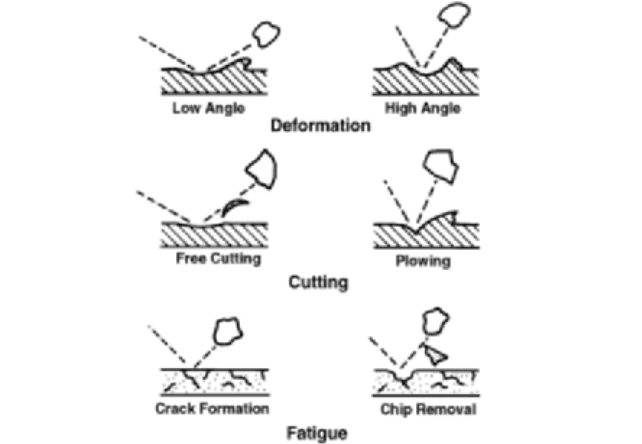
9.364 CHAPTER NINE
FIGURE 16 Mechanisms of particle-impact erosion
the stress normal to the surface is caused by gravity. For sliding abrasion, the erosion rate
depends on the properties of particles and wear surfaces, the normal stress, and the rela-
tive velocity.
The normal stress is enhanced when the flow streamlines are curved, as in a pump cas-
ing. In this case there is a centrifugal acceleration, equal to u
2
/r, where u is the local veloc-
ity and r is the radius of curvature of the streamlines. This acceleration can often be much
greater than that of gravity, producing a commensurate increase in the normal stress
between the moving contact-load solids and the wall material, and hence a greatly
increased rate of sliding-abrasion wear. This type of behavior can cause a pump casing to
wear through when adjacent straight-pipe sections of the same material have hardly been
affected by erosion. Near the tongue of the pump casing, however, the other major wear
type is more significant.
The second type of wear is the particle-impact mode, which occurs where individual
particles strike the wearing surface at an angle, despite the fact that the fluid component
of the slurry is moving along the surface (Figure 16). Removal of material over time occurs
through small-scale deformation, cutting, fatigue cracking, or a combination of these, and
thus depends on the properties of both the wearing surface and the particles. Ductile
materials tend to exhibit erosion primarily by deformation and cutting, with the specific
type depending on the angularity of the eroding particles. Brittle or hardened materials
tend to exhibit fatigue-cracking erosion under repeated particle impacts. For a given
slurry, the erosion rate depends on properties of the wearing surface: hardness, ductility,
toughness, and microstructure.The mean impact velocity and mean angle of impact of the
solids are also important variables, as are particle characteristics such as size, shape, and
hardness, and the concentration of solids near the surface.
As wear mechanisms vary considerably, so also do the engineering materials that resist
them. A survey of all the available wear-resistant materials and their applications would
provide subject matter for a volume in itself. Nevertheless, there are a few groups of mate-
rials that have found widespread successful application against erosion in slurry systems,
and thus merit particular attention. These materials fall into the broad categories of hard-
ened metals, elastomers (rubbers and urethanes), and ceramics. Materials in each of these
9.16.2 APPLICATION AND CONSTRUCTION OF CENTRIFUGAL SOLIDS HANDLING PUMPS 9.365
categories have their advantages and disadvantages, and the final choice of a material
must account for wear resistance, strength, ease of maintenance, direct cost, and indirect
costs such as plant downtime for maintenance, or failure, safety of operation, and effect on
system efficiency.
Within the metals group, superior wear resistance is given by the high-alloy white cast
irons, particularly nickel-chrome (for example, NiHard), chromemoly (for example, 15%
chromium and 2% molybdenum), and high chrome (for example, 27% chromium) alloys.
These materials exhibit higher hardness (600 plus Brinell), but less toughness than steel
alloys of similar tensile strength. The high carbon content and resultant massive carbides
present in these metals gives them excellent resistance to all forms of particle erosion,
especially in sliding or impact at low angles (cases often encountered in slurry applica-
tions). For the coarsest slurries, hard metal is common, principally the so-called NiHard,
high-chrome, or chrome-molybdenum alloys of 600
—
700 Brinell hardness.
For slurries without coarse particles, elastomers such as rubber, neoprene, and ure-
thane tend to wear better than hard metal, especially for liners and shells. This improve-
ment applies only if there is no “tramp” (that is, extraneous material such as tools, bolts,
or pieces of broken castings). Elastomer selection may also be determined by the corrosive
characteristics of the slurry. Natural soft rubber remains an excellent and economical
pump lining material to handle fine abrasive and corrosive slurries. Carbon black can be
added for additional strength, hardness, and tear resistance, to better withstand the
impact of large particles in the slurry. Like all other materials, rubber has limitations that
should be considered in the selection process. Wear rates in the presence of coarse mater-
ial or high tip speeds may make it uneconomical, and tramp material or adverse suction
conditions can tear the rubber. High temperature or the presence of oils or chemicals may
require the use of one of the higher-cost synthetic materials. For example, neoprene has
been found to tolerate higher temperatures and higher impeller tip speeds than can be
used with natural rubber.
CALCULATION OF SLURRY PUMP WEAR ________________________________
The general selection rules noted earlier aim at keeping wear to generally acceptable levels,
but are otherwise non-quantitative. Finite element and other methods such as those
described by Addie et al. (1996) or Pagalthivarthi (1991) are now available. They allow parti-
cle velocities inside a pump to be calculated, which, using material wear tests coefficients as
described by Pagalthivarthi (1990), can be used to determine wear rates and component lives.
For example, numerical simulations allow calculation of wear around the periphery of
a given pump shell for a given set of conditions. Figure 17 is an example of how wear
varies with different flows from Roco et al (1983). Addie et al. (1987) shows also how a par-
ticular collector can be altered and optimized for the best possible wear.
Modeling methods of calculating wear inside a slurry pump impeller and in the nose
sealing face area are also being developed so in the near future it will be possible to evalu-
ate the wear of the complete pump in a given application. Although all of these methods
cannot predict three-dimensional turbulent wear, they are now opening up the possibility
of better designs, better selection, and the calculation and evaluation of the total cost of
ownership, Addie et al (1998), and the benefits that could come from that.
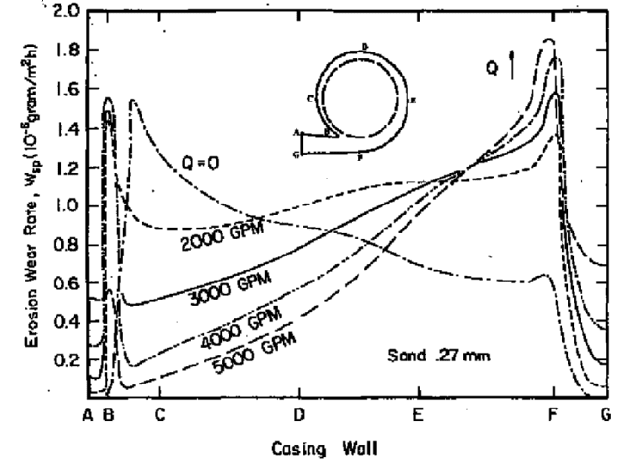
9.366 CHAPTER NINE
FIGURE 17 Erosion wear distributions calculated at different flow rates. [Note: for flow in l/m, multiply gpm by
3.79; for particle size in inches, divide mm by 25.4.]
REFERENCES _______________________________________________________
Addie, G. R., and Helmly, F. W. (1989). Recent Improvements in Dredge Pump Efficiencies
and Suction Performances. Proc. CEDA Dredging Day, Amsterdam.
Addie, Graeme R., Pagalthivarthi, K. V., and Visintainer, R. J. (1996). Centrifugal Slurry
Pump Wear, Technology, and Field Experience. Proc. ASME Fluids Meeting, San Diego, CA,
pp. 703
—
716.
Addie, Graeme R., and Carlson, R. R. (1998). Tools and Technology for Selecting Slurry
Pumps. CIM Montreal ‘98.
Addie, G. R., Visintainer, R. J., and Roco, M. C. (1987). Experiences with a Numerical
Method of Calculating Slurry Pump Casing Wear. Proc. 4th International Pump Sympo-
sium and Short Courses.
Cooper, Paul, et al. (1987). Centrifugal Slurry Pump Wear and Hydraulic Studies. Report,
Ingersoll-Rand Company for U.S. Department of Energy Office of Fossil Energy and Pitts-
burgh Energy Technology Center. DE-AC22
—
82PC50035.
Kasztejna, P. J., et al. (1986). Hydraulic Development of Centrifugal Pumps for Coal Slurry
Service. Proc. 8th International Symposium on Coal Slurry Fuels Preparation and Uti-
lization, pp. 646
—
665.
Maciejewski, et al. (1993). Transport of coarse rock with sand and clay slurries, Proc.
Hydrotransport 12, BHRA Fluid Engineering, Cranfield, UK, pp. 705
—
741.
Pagalthivarthi, K. V., and Helmly, H. W. (1990). Application of Materials Wear Testing to
Solids Transport via Centrifugal Slurry Pumps. Wear Testing of Advanced Materials,
ASTM STP 1167, Divakar and Blau, eds. American Society for Testing Materials,
Philadelphia, PA.
9.16.2 APPLICATION AND CONSTRUCTION OF CENTRIFUGAL SOLIDS HANDLING PUMPS 9.367
Pagalthivarthi, K. V., Desai, P. V., and Addie, G. R. (1991). Quasi-3D Computation of Tur-
bulent Flow in Centrifugal Pump Casings. Proc. ASME Symposium on Multidisciplinary
Application of CFD.
Roco, M. C., and Addie, G. R. (1983).Analytical Model and Experimental Studies on Slurry
Flow and Erosion in Pump Casings. Proc. 8th International Conf. Technology. Slurry
Transportation Association, p. 263.
Sellgren, A., and Addie, G. (1993). Solids effects on the characteristics of centrifugal slurry
pumps. Proc. 12th International Conference on the Hydraulic Transport of Solids in Pipes,
Brugge, Belgium, pp. 3
—
18.
Sellgren A., and Addie, G. (1996). Pump and pipeline solids effects of transporting sands
with different size distributions and concentrations. Proc. 13th International Conference
on the Hydraulic Transport of Solids in Pipes, Johannesburg, South Africa, pp. 227
—
236.
Sellgren, A., and Vappling, L. (1986). Effects of Highly Concentrated Slurries on the Per-
formance of Centrifugal Pumps. Proc. International Symposium on Slurry Flows, FED Vol.
38, ASME, USA, pp. 143
—
148, 1986.
Sellgren, A., Addie, G., and Wei-chung, Y. (1997). Effect of Coarse and Heavy Solid Parti-
cles on Centrifugal Pumps Head and Efficiency. 47th Canadian Chemical Engineering
Conference, Edmonton, AB.
Wilson, K. C., Addie, G. R., Sellgren, A., and Clift R. (1997). Slurry Transport Using Cen-
trifugal Pump, 2nd edition. Blackie Academic and Professional, London.
9.16.3
CONSTRUCTION OF SOLIDS-
HANDLING DISPLACEMENT
PUMPS
WILL SMITH
9.369
APPLICATIONS ______________________________________________________
Positive displacement pumps are especially suited for many solids-pumping applications
because constant high pressures and good efficiency are achieved over the full range of
pump capacities. Low relative velocities between abrasive liquid-solids mixtures and the
pump parts minimize erosion. With centrifugal pumps, an increase in system resistance,
such as a flow blockage caused by settled solids or the apparent viscosity increase charac-
teristic of many slurries due to momentary capacity reduction, results in a self-defeating
reduction in pump flow rate.
Positive displacement pumps are popular for a number of solids-handling applications.
Each application presents peculiar demands for pump features.
Solids Transport Large-capacity positive displacement pumps at moderate pressures
are used to pump coal and ores over relatively long distances. Solids for transport are usu-
ally slurried with water and are pumped at ambient temperatures. Double-acting hori-
zontal piston pumps with large, “mud pump” valves and piston rings (Figure 1) typify
transport service.
Most pipelines have multiple pumping stations at intervals along the route, dictated by
topography and by pipeline and pumping station first and operating cost balances. Cen-
trifugal booster pumps are employed at the first station to deliver the prepared slurry to
the displacement pumps at a sufficient pressure to satisfy their NPSH, including acceler-
ation head, requirement. Subsequent stations are located at points where there is suffi-
cient residual pipeline pressure to fulfill the displacement pump’s suction requirements.
The capacity of each station is adjusted by pump speed control so the next station’s inlet
pressure is kept relatively constant.
Most stations muse multiple positive displacement pumps in parallel, with at least one
standby pump. Capacity modulation requires but one of the pumps to be operating with
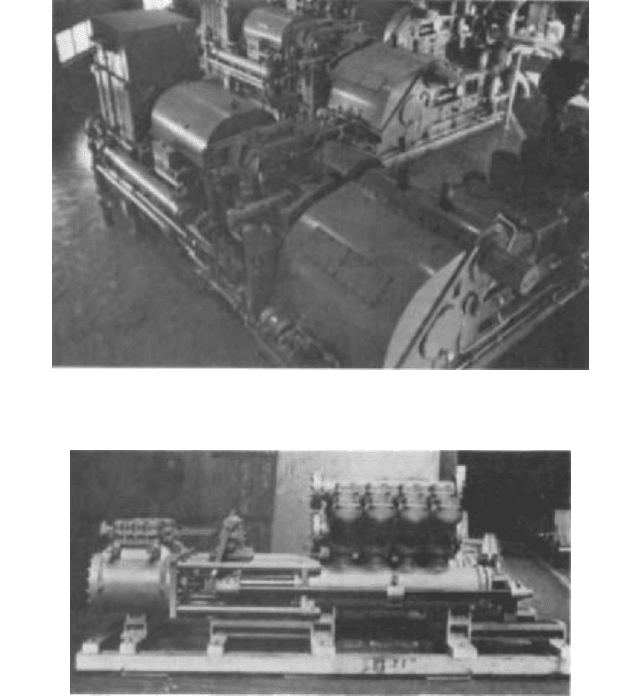
9.370 CHAPTER NINE
FIGURE 1 Horizontal double-acting duplex coal slurry pipeline pumps (Black Mesa Pipeline, Oil Well Div. of U.S.
Steel)
FIGURE 2 Horizontal double-acting plunger pump for slurry of grain mash and water for alcohol production
(Flowserve Corporation)
speed control, although all are generally so fitted. Unlike centrifugal pumps, displacement
pumps can provide full rated pressures at all speed-controlled capacities.
Process Pumping Some chemical and petroleum processes require pumping of solids
to high pressures for process reactions. Typical of these are bauxite ore in hot caustic for
alumina plants, ground coal in water or coal liquids for synthetic fuel production, and
grain in water for alcohol production (Figure 2).
Process streams involve a vast variety of liquids and solids. Concentrations may be as
high as 70% solids by weight. Temperatures can reach 800°F (427°C). Pressures from sev-
eral hundred to many thousands of pounds per square inch are accommodated.
Other Specialty Services A number of specialty services employ positive displacement
pumps to handle solids. Some are relatively simple applications of standard catalog
pumps, and others are single-purpose developments and thus have evolved with unique
characteristics.
9.16.3 CONSTRUCTION OF SOLIDS-HANDLING DISPLACEMENT PUMPS 9.371
Mud pumps are used to inject drilling mud, which transports cuttings out of wells and
lubricates the drill bit during well drilling. Because of the limited duration of a drilling
project, the life of expendable parts (packing, valves, rods) is compromised in favor of size
and weight for portability and ease of overhaul. Sludge disposal pumps are common in
sewerage treatment plants, and tailings pumps move solids out of mines.
PUMP CONSTRUCTION _______________________________________________
Solids-handling displacement pumps differ from ordinary displacement pumps in the
means used to alleviate the deleterious effects of the solids on the packing, the displace-
ment element (whether plunger, piston, or diaphragm), and the suction and discharge
check valves. To protect parts from the ravages of the solids, (1) particles are prevented
from entering close clearances, (2) operation is at lower speeds to reduce the effects of ero-
sion and abrasion, or (3) the susceptible parts are made of wear-resistant materials.
Because sacrificial wear parts must be replaced more often than in clear liquid pumps,
special design attention for ease of replacement of these parts is justified.
The designer’s choice is between hard materials that resist wear and resilient materi-
als that may accommodate the particles of solids. This choice is often limited by other fac-
tors, such as temperature and chemical compatibilities. Hard materials used include
Tungsten carbide
Ceramics
—
chrome oxide and aluminum oxide
Hardenable stainless steel
Cobalt-nickel alloys
Some common soft materials are
Synthetic elastomers
Softer metals (sacrificial)
Unlike centrifugal pumps, positive displacement pumps are more prone to abrasive
than erosive wear. This is due to the much lower relative velocities between the liquid and
the pump parts. Centrifugal pumps must generate high relative velocities, typically
greater than 100 ft/s (30 m/s), for the dynamic specific energy that is converted to dis-
charge pressure. Positive displacement pump velocities are kept low, limited usually by the
settling velocity of the slurry, which is on the order of less than 10 ft/s (3 m/s).
There are four types of positive displacement solids-handling pumps:
1. Reciprocating piston pumps
2. Reciprocating plunger pumps
3. Diaphragm pumps
4. Hydraulic displacement pumps
Valves Common to all types are suction and discharge check valves, the purpose of
which is to allow the solids-laden liquid to flow into the pump from the suction line and
into the discharge line from the pumping chamber while preventing backflow. The features
of slurry valves include
1. Large areas for low flow velocity
2. Smooth, unobstructed passages to avoid trapping and build-up of solids
3. Special designs to enhance sealing against pressure in the closed position
4. Special materials to minimize wear
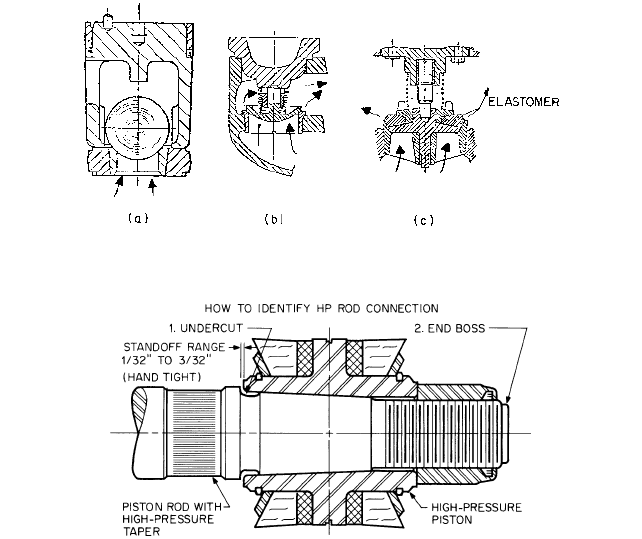
9.372 CHAPTER NINE
FIGURE 3A through C Three types of slurry valves: (a) free-floating ball valve, (b) spring-loaded spherical
(Rollo) valve, (c) spring-loaded elastomer-seal (mud) valve
FIGURE 4 Double-acting mud pump piston. Standoff range varies between 0.030 to 0.090 in (0.75 to 2.25 mm).
Figure 3 illustrates some valves developed particularly for solids-handling pumps.
Which valve is selected for a particular application depends on the abrasiveness, viscosity,
temperature, solids size, and uniformity of the slurry. It is important that the valve lift be
sufficient to pass the largest particles of solids expected. Adequate sealing in the closed
position is necessary to avoid excessive back leakage, which detracts from the volumetric
efficiency of the pump.
Valve materials must meet temperature, corrosion, abrasion, and mechanical strength
requirements. Materials for valves and seats range from cast iron and bronze through hard-
enable stainless steels to solid tungsten carbide. The cost of replacement or refurbishment
over the expected life, including labor and downtime, should be balanced against first cost.
Packing Protection A distinguishing feature of solids-handling displacement pumps is
the means used to avoid or minimize packing wear. Five different approaches are
1. Use of conventional designs with special materials and operation at less demanding
conditions, such as reduced speeds
2. Provision of a clean nonslurry environment for the packing rubbing surfaces
3. Separation of the slurry from the displacement element
4. Separation of the slurry from the pumping element
5. Total isolation of the slurry from the packing
CONVENTIONAL DESIGN WITH MODIFIED OPERATION Piston pumps usually fall into this cate-
gory. By using larger pumps at speeds that are lower than those normally found with clear
fluids, velocity-sensitive wear rates are reduced. Special piston rings (Figure 4) are used
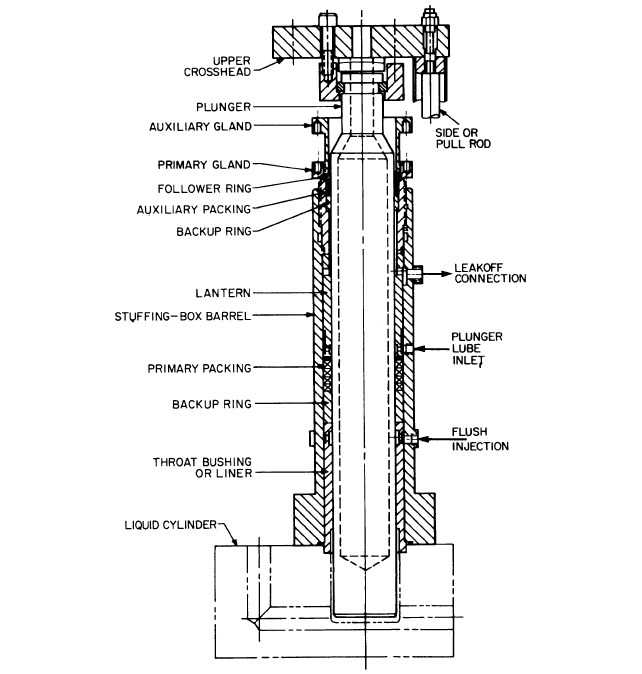
9.16.3 CONSTRUCTION OF SOLIDS-HANDLING DISPLACEMENT PUMPS 9.373
FIGURE 5 Typical flush injection
that tend to resist abrasion because they are made of zero clearance elastomeric materi-
als and designed to scrape clean the cylinder wall. Such piston packing is a normal wear
item and must be replaced at regular intervals.
CLEAN NONSLURRY ENVIRONMENT This is accomplished by the injection of clear liquid (Fig-
ure 5). Such injection may be either continuous or synchronized with the stroke of the
plunger or piston. When effectively accomplished, flush injection presents essentially clear
pumpage to the packing so it attains normal clear liquid packing life. Flush liquid that
enters the pumping chamber dilutes the pumpage and decreases the suction volumetric
efficiency.
Clear, compatible flush liquid may be scarce or expensive. Therefore special stuffing
box plus flush injection systems have been developed. Required flush rates are a function
of pump type and size and system employed. Satisfactory operation has been attained
with flush rates of about 2 to 5% of pumped flow and even less for very large pumps. If
other than a positive displacement flush pump is used, flush flow will increase as packing
and throat bushings wear.
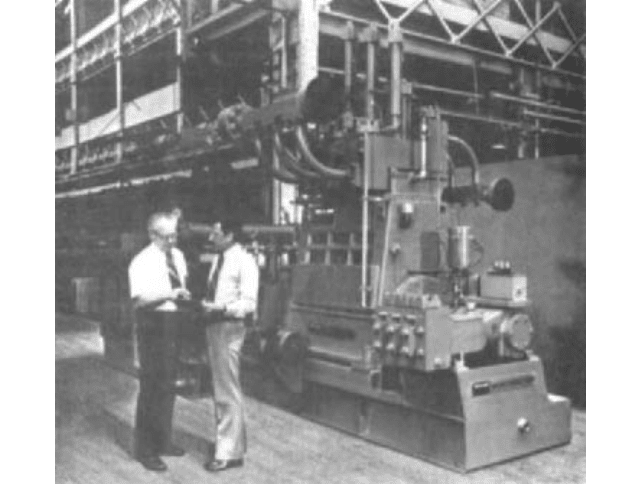
9.374 CHAPTER NINE
FIGURE 6 Vertical single-acting triplex plunger pump with synchronized flush liquid injection (Flowserve
Corporation)
Flushing prevents incursion of slurry particles by providing a liquid velocity counter to
the unwanted slurry flow in clearances and by washing solids particles from the plunger
or rod surfaces as they move toward the packing. Injection systems may be as simple as a
constant-pressure liquid fed to a point between the packing and the throat bushing or as
complex as a sophisticated synchronized injection system involving an additional positive
displacement pump driven directly from the slurry pump drive train and independently
furnishing a definite quantity of flush fluid to each plunger or piston during each pump
stroke (Figure 6).
Combinations of positive, independent, synchronized pumped injection, and auxiliary
buffer liquids have been proposed for very special situations.
SEPARATION OF SLURRY FROM DISPLACEMENT ELEMENT One means of reducing the concen-
tration and temperature of slurry at the pump packing is the use of a liquid, or surge, leg
(Figure 7). The displacement element
—
plunger or piston
—
is separated from the suction
and discharge valves by a length of pipe that is filled with clear liquid.This liquid leg com-
municates with the valve chambers such that, as the liquid ebbs and flows in response to
the motion of the displacement element, it acts as a liquid piston, inducing and then
expelling slurry through the suction and discharge valves. Make-up liquid is injected into
the surge leg, preferably through a throat bushing isolating the displacement chamber
from the packing so there is theoretical flow away from the stuffing box. The surge leg
thus offers the packing some degree of protection from the solids and from thermal effects.
Surge legs are, however, subject to the complete span of suction-to-discharge pressure
change on each stroke. Therefore they must be designed for endurance fatigue loading.
When high-temperature isolation is involved, thermal expansion and contraction must
also be considered. Although surge leg pumps have been demonstrated to increase piston
or plunger packing life, they do not totally prevent solids migration from the pumping
